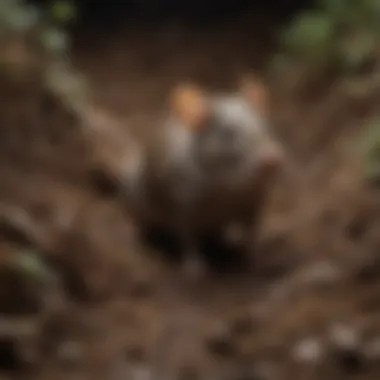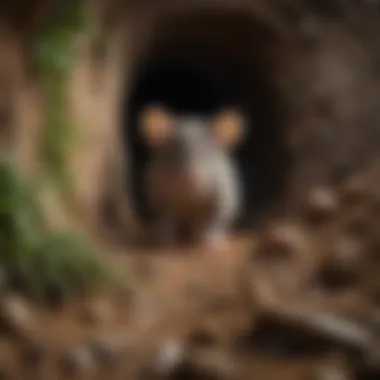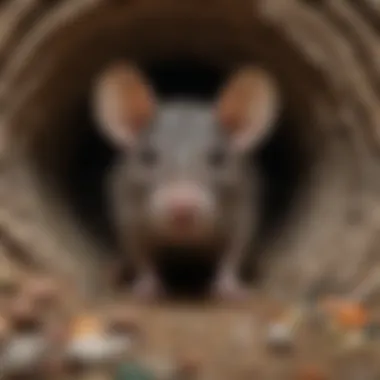Exploring the Role of Tunneling Rats in Ecosystems


Intro
When you think of tunneling creatures, you might picture moles or perhaps even earthworms. However, tunneling rats play a prominent role in shaping their habitats and maintaining the ecosystem. These clever little rodents are often underestimated and overlooked. Yet, their tireless digging not only influences the structure of the soil but also has a cascading effect on plant growth and local wildlife.
This article takes a dive into the intriguing realm of tunneling rats, showcasing their behavior, social structures, and the critical importance of their tunneling activities. From the damp corners of urban landscapes to sprawling grasslands, rats serve as a testament to the adaptability of life.
As we explore different rat species, we'll uncover how these small mammals manage to thrive in various environments. Their connections to soil health and plant proliferation form stories that have largely gone unnoticed by the average observer. Together, let’s illuminate the hidden world of tunneling rats—rodents that make a significant impact, even as they scurry unseen beneath our feet.
Understanding Tunneling Behavior
Tunneling behavior in rats is a captivating topic that sheds light on how these creatures adapt and thrive in their environments. By understanding this behavior, we can appreciate the remarkable strategies that rats use for survival. Tunneling offers insights into their social structures, feeding habits, and interactions with the ecosystem. The intricate tunneling networks serve as a window into their lives, revealing not just their instinctual drives but also how they contribute to the soil health and plant growth of the places they inhabit.
The Mechanics of Digging
The mechanics behind a rat’s digging abilities are fascinating. Rats possess strong forelimbs that are perfectly suited for excavation. Their powerful claws allow them to move soil efficiently, creating extensive tunnel systems that can stretch for many meters underground. These networks are not simply holes in the ground; they are meticulously crafted pathways that serve various purposes, from food storage to predator avoidance.
Rats also have specialized teeth that help them gnaw through roots and other underground materials. Their unique body structure allows them to maneuver easily through narrow tunnels, where it would seem impossible for a creature of their size to operate. This physical prowess of tunneling rats combines strength, agility, and a natural instinct to dig, contributing significantly to their survival and ecological role.
Purpose of Tunnels
The reasons why rats dig tunnels are diverse, and each serves a significant role in their lifestyle and survival. Understanding these purposes can shine a spotlight on the intricate nature of their interactions with the ecosystem.
Food storage
Food storage is a critical aspect of tunneling behavior among rats. By excavating deep tunnels, they create chambers where they can hoard food. This strategy not only ensures a sustainable food supply during lean times but also keeps their food hidden from potential predators. Since food scarcity can strike at any moment, this kind of preparation is paramount for their survival.
One key characteristic of food storage is its role in promoting a rat’s survival rates during winter months or in times of drought. They instinctively go back to these covert caches of food in tough times, showcasing an innovative method of self-preservation. However, a unique feature is that sometimes, if conditions change or other issues arise, these caches can become lost or forgotten, which could also lead to plant growth benefiting from the unattended seeds.
Predator evasion
Predator evasion is another pivotal reason rats dig tunnels. These underground systems provide a sanctuary from above-ground threats, such as birds of prey or other mammals. The tunnels serve as a reliable escape route and a refuge where rats can evade danger.
The key characteristic here is the safety that tunnels provide. They act like a fortress against threats, allowing rats to emerge only when they are sure the coast is clear. However, the unique feature of these tunnels is their complexity. The winding paths can confuse predators, making it difficult for them to follow the scent or track movements. This advantage can significantly enhance the chances of survival for these rodents.
Microclimate regulation
Microclimate regulation is a fascinating aspect of tunneling rats that often goes unnoticed. By digging underground, rats can create a stable temperature and humidity level within their tunnels, which helps protect them from extreme weather conditions.
The key characteristic here is that these underground environments often remain cooler during hot weather and insulated during cold periods. This offers a critical advantage not just for the rats but also for their surrounding ecosystem. A unique feature of microclimate regulation is that it can promote the growth of fungi and other microorganisms beneficial for soil composition.
By helping maintain a stable microclimate, tunneling rats inadvertently support the health of the overall ecosystem, demonstrating how their behavior affects various biological processes.
"Understanding the complexities of tunneling behavior not only helps us appreciate rats but also highlights their ecological significance in maintaining environmental balance."
In closing, tunneling behavior is a multifaceted trait that highlights the adaptability of rats. These rodents have honed their digging skills to create tunnels that serve numerous survival needs, which in turn affects their ecosystems in surprising and beneficial ways. Examining the nuances of this behavior allows us to grasp the broader significance of these often-maligned animals in our world.
Geographic Distribution of Tunneling Rats
Understanding the geographic distribution of tunneling rats is not just an exercise in mapping their habitats; it's crucial for grasping their role in various ecosystems. For instance, these rodents adapt expertly to their environments, and this adaptation can provide insights into ecological balance, food chains, and even soil health. By identifying where these mammals thrive, we can better appreciate their contributions to local biodiversity, as well as the challenges they face in different regions.
Habitat Preferences
Urban environments
Urban areas are a hotspot for tunneling rat activities, often serving as a playground of sorts, where they thrive amidst the concrete jungle. The key characteristic of urban environments here is the abundance of food sources and shelter. Rats can find discarded food and nesting places in shrubbery or even under building foundations.
This adaptability makes urban settings a popular choice for these rodents. However, it’s not all sunshine and rainbows. The unique feature of urban environments, like high-density human populations, often leads to increased human-rat interactions. This can be problematic, as it raises concerns about public health and pest management, creating a tug-of-war where cities must balance ecological realities against urban planning and hygiene efforts.


Rural settings
Rural settings present a different canvas for tunneling rats. Here, the landscape typically offers vast stretches of fields and farmland, making these settings rich in nutritional opportunities. The key characteristic of rural habitats is the mix of crops, gardens, and natural flora, which provides food and protection from predators.
Rural environments support the tunneling lifestyle well, featuring loose soil that’s easier to dig through and ample access to cultivated plants. One unique aspect of rural settings is that they may lead to mutualistic relationships with farmers, who benefit from the aeration of soil due to tunneling. However, these settings also come with disadvantages; agricultural practices can sometimes disrupt natural habitat, leading to displacement and changing population dynamics for rats.
Natural ecosystems
Natural ecosystems are the backbone of ecological balance, and tunneling rats are key players within them. The primary feature of these ecosystems is their complexity; they include forests, grasslands, and wetlands that not only support a variety of species but also provide a nutrient-rich environment for tunneling rats. Here, the interaction between these mammals and their surroundings highlights their role in nutrient cycling and soil aeration.
Choosing natural ecosystems for habitation offers tunneling rats a range of advantages, including minimal human disruption and a plethora of food sources from native plants. However, these environments face pressures from climate change and habitat destruction, affecting not only the tunneling rats but the entire biodiversity they help sustain.
Species Diversity
Common species in North America
In North America, several species dominate the tunneling scene. The Norway rat and the Eastern wood rat, for example, are commonly associated with urban and rural habitats. One key characteristic of these species is their extraordinary adaptability, allowing them to thrive in diverse environments—from bustling cities to quiet suburbs.
The unique feature of common species in North America is their varied dietary preferences, which can include everything from human scraps to organic waste. This flexibility makes them successful survivors, although they may alter local ecosystems by competing for resources with native species.
Tunneling species in Europe
European tunneling rats, like the Brown rat and the Black rat, have made their mark in various habitats. Their key trait lies in their burrowing efficiency, which helps them create extensive tunnel networks. This is particularly beneficial in agricultural areas where these rats can support soil health by aerating it while also posing challenges for farmers.
The unique aspect of tunneling species in Europe is their long-standing relationship with people. Over centuries, these rats have learned to cohabit with humans, leading to diverse challenges and often contentious interactions. Understanding these relations emphasizes the ecological and economic impacts of tunneling rats across Europe.
Colonial vs. solitary tunneling rats
The social structure of tunneling rats can vary significantly between colonial and solitary species. Colonial tunneling rats, such as the Norway rat, often live in groups, showcasing hierarchical structures that aid in cooperative digging and resource sharing. This group mentality is essential for survival, as they can defend against predators more efficiently.
On the flip side, solitary tunneling rats, like some species in the wild, adopt a more independent approach, allowing them to select specific habitats for nesting and hunting. This choice can provide flexibility at the cost of cooperative safety. Assessing the balance between colonial and solitary behavior sheds light on social dynamics among tunneling rats, which can have significant implications on their population and ecological roles.
Anatomy and Physiology of Tunneling Rats
Understanding the anatomy and physiology of tunneling rats is crucial, as these aspects directly impact their ability to adapt and thrive in subterranean environments. Various features have evolved in tunneling rats, allowing them to dig efficiently, navigate in darkness, and effectively sense their surroundings. By delving into these adaptations, we can better appreciate the unique role tunneling rats play in ecosystems and their intricate behavior.
Adaptations for Digging
Strong forelimbs
The strong forelimbs of tunneling rats play a vital role in their digging capabilities. These limbs are not just muscular but are designed to provide the necessary power and precision for excavation. The ability to push through difficult soil is a key aspect that supports their tunneling lifestyle. One remarkable feature of their forelimbs is the enhanced strength in their wrist and forearm muscles, which helps them displace soil effectively. This uniqueness is advantageous, allowing for faster tunneling, essential for avoiding predators while foraging or creating shelters. However, this strength comes with a cost; the overall body balance shifts towards the front, which may leave the hindquarters less robust, somewhat impacting mobility above ground.
Specialized teeth
Another significant characteristic of tunneling rats is their specialized teeth. These teeth are not just for eating; they have evolved to assist in digging as well. The incisors of tunneling rats are particularly noteworthy; they are sharp and continuously growing, which makes them effective for gnawing through tough roots and other obstacles found underground. This feature provides dual functionality, aiding both in feeding and burrowing. While this attribute is undeniably beneficial, it also requires constant wear to prevent overgrowth, presenting a challenge for managing dental health in these animals.
Flexible body structure
A flexible body structure sets tunneling rats apart in their adaptations. Their bodies can twist and turn in tight spaces, which is an essential trait for moving through narrow tunnels. The notable aspect of this flexibility is the lack of rigid spine, allowing for a more fluid motion in their burrowing activities. This flexibility is particularly advantageous when navigating complex tunnel systems where precise movements are vital. Nevertheless, having such a body structure can pose challenges during growth phases, as it may limit their agility above ground when encountering open spaces.
Sensory Capabilities
Use of whiskers
Whiskers in tunneling rats are more than just sensory hairs; they are essential for spatial awareness. These long, sensitive whiskers help the rats detect minute changes in their environment, allowing them to navigate tight tunnels with ease. The primary feature of these whiskers is their highly sensitive tips, which can sense vibrations and air currents. This attribute proves beneficial as it helps them avoid obstacles when they are in complete darkness of their tunnels. However, their heavy reliance on whiskers also means that any damage to these sensory organs can severely affect their navigation abilities underground.
Burrowing in darkness
Tunneling rats have adapted to burrowing in darkness, relying heavily on alternative sensory inputs to guide their movements. They possess excellent spatial memory and can map out their tunnel systems mentally, which aids in movement through unfamiliar sections. The ability to rely on their other senses makes this a strong point for their lifestyle, ensuring they can explore further without losing their path. On the flip side, the lack of visual reliance may render them vulnerable if they need to escape quickly during a crisis, often leading to miscalculations in unfamiliar terrains.


Vibrational sensing
Vibrational sensing is an extraordinary adaptation in tunneling rats, allowing them to detect vibrations in the ground, which signal the presence of potential predators or competing species. This ability comes from specialized organs that pick up on low-frequency vibrations. Such a feature is crucial in their survival, detailed and nuanced enough to alert them of movements around or above them. While effective, this sensitivity can also overwhelm them in busy environments where vibrations come from multiple sources, creating confusion and stress.
"The physiology of tunneling rats exemplifies nature's clever design, showcasing how evolution tailors creatures to suit their environments, ensuring survival in a world teeming with challenges."
Through a thorough exploration of their anatomical and physiological characteristics, it becomes clear that tunneling rats possess an impressive array of adaptations. These adaptations not only facilitate their tunneling instincts but also enrich the ecosystems they inhabit.
Social Structures within Tunnel Systems
The social structures within tunnel systems of tunneling rats reveal a complex, fascinating interplay of behavior and survival. These systems not only provide shelter and protection but also shape the social interactions among the rats. Understanding these dynamics can shed light on the broader implications these animals have in their ecosystems and their behavior as a species. The way these rats organize themselves has key advantages: it aids in collective survival, efficient resource use, and ensures the stability of their communities.
Colonial Living
Hierarchy among rats
Hierarchy plays a significant role in the social structures of tunneling rats. In colonies, there often exists a ranking system that influences access to resources and mate selection. The dominant individuals typically have first dibs on food and prime sleeping areas, which can lead to stronger survival for their lineage. This hierarchical structure is not merely a 'pecking order'; it’s a refined system that impacts reproduction rates and overall health of the population.
A notable characteristic of hierarchical systems is the way subordinates can gain favor by providing assistance or support in routine tasks like digging or foraging. While it might seem advantageous for the dominant rats, there are drawbacks. High agression and stress among lower-ranked rats can occasionally lead to conflicts, undermining the colony’s welfare.
Cooperative tunneling
Cooperative tunneling is a fascinating aspect of how these rats engage in their burrowing activities. Instead of each rat digging solo, many work together to expand their complex systems. This teamwork enhances tunnel expansion and maintenance efficiency, ensuring that all members benefit from the communal effort. The primary advantage of cooperative tunneling lies in the speed and effectiveness it brings. With more paws at work, the tunnel system grows faster, providing immediate advantages like escaping predators or reaching food sources quicker. However, this collaboration also comes with risks, as it requires constant coordination and trust among members, which could falter during stressors like food scarcity.
Resource sharing
Resource sharing is vital in sustaining the community within tunnel systems of rats. When food is plentiful, sharing becomes a natural behavior that reinforces social bonds and promotes group survival. By pooling resources, tunneling rats optimize their nutritional intake and reduce competition among themselves. A key feature of resource sharing is the reciprocal nature of these interactions, where one rat’s gift is often later returned in kind, thus fostering a tight-knit community. This strategy comes with its challenges, as imbalances in resource availability can lead to discord and potential social rifts, impacting the overall stability of their networks.
Territorial Behavior
Marking territories
Territorial behavior is another important aspect of tunneling rats. By marking their territories with scent, these rats communicate ownership and deter intruders. This marking helps maintain boundaries within their social structure, enabling clear divisions of space that create less conflict within the community. The clarity of territorial marking is a beneficial choice for maintaining peace among groups; however, disputes can occasionally arise, especially when resources are limited. This system is both a boon for population management and a potential source of friction.
Defending tunnel networks
Defending tunnel networks is critical for the survival of tunneling rats. When threatened, they will fiercely protect their homes against predators or rival rats. This instinctual behavior ensures that their nested young are safe and that the resource-rich environment they’ve built remains undisturbed.
A defining characteristic of this defense system is the combination of stealth and aggression, allowing them to ward off threats effectively. The downside, however, is the energy expenditure involved, which can be significant, particularly if threats are frequent or persistent.
Mate competition
Mate competition among tunneling rats adds another layer of complexity to their social systems. In many species, males often vie for the attention of females, displaying intense competition that can lead to conflicts. This competition generally results in stronger, healthier offspring, ensuring the survival of the fittest. One interesting feature of mate competition is its impact on social hierarchies; dominant males tend to secure the most mating opportunities. However, this behavior drives less dominant males to engage in clandestine or alternative strategies, such as sneaky copulation, which adds drama to their social dynamics. While beneficial for genetic diversity and population health, it can also lead to rivalry and stress within the group.
Environmental Impact of Tunneling Activities
Tunneling rats play a pivotal role in their ecosystems, and their activities can significantly transform the landscape. Their burrowing does not merely serve a survival function; it also creates a cascade of environmental effects that influence other species and the overall health of their habitats. Understanding these impacts is essential for appreciating the ecological contributions of tunneling rats.
By digging intricate tunnel networks, these rodents create pathways that facilitate air and water movement through the soil, thus promoting healthier grounds for plant growth. Their burrowing behaviors ultimately lead to richer biodiversity and enhance the resilience of ecosystems. Here, we delve into some specific impacts that tunneling rats have on soil properties and plant growth.
Soil Aeration and Composition
The aeration and composition of soil are vital factors for a robust ecosystem. When tunneling rats create their elaborate tunnel systems, they unwittingly perform a vital service of aerating the soil. These underground channels allow air to circulate better, which is crucial for beneficial soil microbes. Good aeration can help reduce the risks of soil compaction, a condition detrimental to plant roots that require oxygen.
Moreover, the organic matter from the rats' waste enriches the soil nutrients, leading to enhanced overall soil composition. This cycle of digging, feeding, and defecation helps in creating more fertile grounds, enabling plant species to thrive.
Effects on Plant Growth
The activities of tunneling rats have multifaceted effects on plant growth, which can be categorized into three main themes: enhancement of nutrient cycling, influence on root systems, and impact on crop yields. Each aspect elaborates on how these rodents contribute positively or negatively to their ecosystems.
Enhancement of nutrient cycling
Tunneling rats' burrowing practices enrich the soil, enhancing nutrient cycling significantly. When these creatures dig, they mix organic matter with the soil, making nutrients more available to plants. This dynamic process speeds up the decomposition of organic materials, benefiting the entire ecosystem.


One key characteristic of this nutrient cycling enhancement is the increase in microbial activity. More microbes mean more organic recycling, which ultimately leads to better plant health. A unique feature in this context is the natural fertilizer effect that occurs when rats urinate and defecate in their burrows. The nutrients from these waste materials bolster soil fertility and promote new plant growth.
However, while the enhancement of nutrient cycling is largely positive, an overabundance of tunneling can lead to soil disturbance, affecting certain plant species negatively. It's a balancing act between ecological benefits and possible disruptions.
Influence on root systems
Rats also impact root systems significantly. Their tunneling loosens the soil structure, which encourages roots to spread more freely and grow deeper. This improved soil texture allows roots to access water and essential nutrients more efficiently.
The key characteristic here is root expansion, which plays a massive role in plant stability and nutrient uptake. An interesting aspect is that these burrows often shield young plants from drought and other stresses while giving their roots a mote of opportunity to explore the moist soil deeper.
Yet, on the downside, tunneling activities can disrupt established root systems, leading to plant mortality. Thus, it's a double-edged sword, presenting both benefits and challenges.
Impact on crop yields
For farming communities, tunneling rats can have a mixed bag of effects on crop yields. On one hand, the mixing of soil and enhancement of nutrients can lead to increased yields. Farmers may also benefit from healthier soil that supports a variety of cash crops.
The character of these impacts illustrates that well-managed tunneling rat populations can serve as natural soil conditioners. However, farmers often face challenges posed by overpopulation, where excessive tunneling can lead to root damage across significant stretches of farmland, ultimately plummeting crop productivity.
In summary, tunneling rats bear influential roles through their activities, crucially affecting soil health and plant growth. As they dig their tunnels, they contribute positively to the ecosystem's foundation while introducing a complex interplay of benefits and drawbacks that necessitate close observation, especially in agricultural landscapes.
Tunneling Rats and Humans
Tunneling rats, often considered pests, have a deeper connection with humans than one might immediately perceive. Their behaviors, ecological roles, and even cultural representations reveal significant ties to our own lives and environments. Understanding these relationships is crucial, especially when addressing the advantages and challenges these creatures bring to agricultural practices, urban settings, and scientific research.
Cultural Significance
Symbolism in Literature and Folklore
Throughout history, rats have found notable place in literature and folklore. They are depicted in a variety of ways—from sly tricksters to messengers of doom. The character of the rat often embodies resilience and adaptability, reflecting human struggles and survival instincts. A common thread in these stories is the rat's ability to thrive even in harsh conditions, embodying a certain tenacity that resonates with readers. This portrayal not only highlights the rat as an unyielding survivor but also invites readers to reflect on broader themes of prejudice and societal values.
Thus, including this perspective in our discussion of tunneling rats serves to deepen our understanding of their role in both nature and shared culture.
Rats in Agriculture
When thinking about agriculture, rats might not seem like helpful allies. However, their behavior in the soil plays a vital role. While they can be pests, their digging activities contribute to soil aeration, improving drainage and promoting nutrient cycling, which can ultimately benefit plant health. For example, certain crops can thrive in well-aerated soil, leading to enhanced yields.
This duality of rats brings to light a beneficial aspect of their presence in agricultural environments. Understanding this can help cultivate more harmonious methods of pest management that take into account the ecological roles these creatures play.
Role in Research
Rats have been treasured in scientific research for decades. Their anatomy, physiology, and behaviors provide insights into various health issues and environmental impacts. For instance, studying tunneling behaviors can reveal information about soil health and biodiversity. Furthermore, as researchers dive deeper into the genetics of these creatures, they illuminate findings that could lead to breakthroughs in human health and medicine.
Incorporating their research value into our understanding highlights the importance of preserving these species. They can serve as important model organisms in studies, yet often face challenges from urban encroachment and habitat destruction.
Urban Management Challenges
Public Health Concerns
Urban environments bring unique challenges concerning tunneling rats. While they play vital ecological roles, their presence in cities raises public health alarms. Rats can be vectors for diseases, and their ability to reproduce rapidly can lead to population outbreaks. Therefore, understanding these risks is essential for urban planning and public health strategies.
Acknowledging these concerns allows for a balanced discussion on how to manage rat populations while minimizing health risks. By studying their behaviors, we can develop targeted strategies that aim to reduce health threats while respecting their ecological significance.
Pest Control Strategies
Navigating pest control can be a double-edged sword; effective strategies must balance eradication with ecological balance. For instance, traditional extermination often overlooks the essential roles tunneling rats play in soil health. Alternatives such as integrated pest management (IPM) encourage the study of rat behaviors to allow compatible cohabitation rather than outright extermination.
Finding ways to manage this species while still ensuring the health of the ecosystem is no small feat. Pest control methods must be informed by a deep understanding of their ecology and behavior, providing pathways to coexist rather than combat.
Balancing Ecological Benefits
While tunneling rats present certain challenges, they also bring undeniable ecological benefits. Their activities contribute significantly to soil quality, influencing entire ecosystems around them. Thus, what we often label as pests are in fact vital ecological players.
To navigate the duality of their role, strategies should be devised that appreciate their benefits and mitigate their drawbacks. By promoting awareness around their ecological significance, we can engage in more effective management practices that respect the natural balance.
Understanding tunneling rats in our urban environments invites a more nuanced perspective on their ecological impact and cultural significance. It encourages a holistic approach to managing their populations that integrates public health, agriculture, and scientific research.







